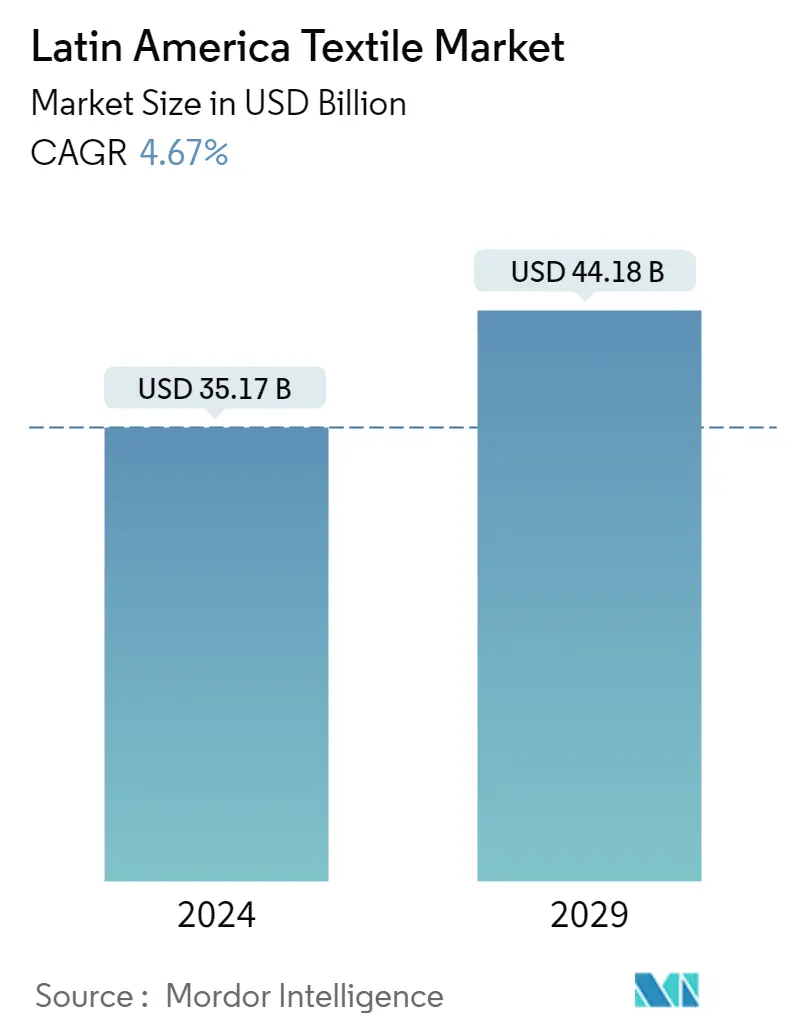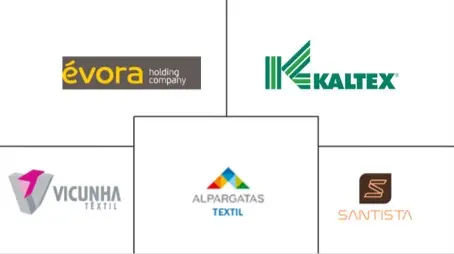Market Size of Latin America Textile Industry

| Study Period | 2020 - 2029 |
| Base Year For Estimation | 2023 |
| Market Size (2024) | USD 35.17 Billion |
| Market Size (2029) | USD 44.18 Billion |
| CAGR (2024 - 2029) | 4.67 % |
| Market Concentration | Low |
Major Players
*Disclaimer: Major Players sorted in no particular order |
Latin American Textiles Market Analysis
The Latin America Textile Market size is estimated at USD 35.17 billion in 2024, and is expected to reach USD 44.18 billion by 2029, growing at a CAGR of 4.67% during the forecast period (2024-2029).
The COVID-19 pandemic, which has caused major disruptions to the international trade flows and global economy, has resulted in a sudden drop in textile productivity in the Latin American region. The pandemic has largely impacted the region. The Mexican textile and clothing market, which is one of the top markets in the region, has been operating the entire supply chain from cotton and other man-made fiber production. Mexico being one of the key suppliers of textiles and clothing to the United States, which sends a large proportion of its textile and related product exports to the United States, has been facing difficulties in manufacturing due to the lockdown and other safety measures. The situation is expected to get back to the pre-COVID-19 scenario slowly, yet the market is anticipated to register a slow growth rate during the forecast period.
Latin America is home to some major textile-producing nations, such as Peru, Brazil, and Colombia. Peru is South America's biggest clothing exporter, and it boasts of unique domestic raw materials, especially alpaca fiber and Tangüis cotton. Brazil, a BRIC country, has enormous growth potential in both its textile supply chains, natural fibers and man-made fibers. Colombia is also expected to witness great opportunities in the textile and fashion market. Meanwhile, the CAFTA-DR countries - Costa Rica, Dominican Republic, El Salvador, Guatemala, Honduras, and Nicaragua - are eagerly competing among themselves and against Haiti for niches in the US market.
Latin American Textiles Industry Segmentation
This report aims to provide a detailed analysis of the textile market in Latin America. It focuses on the market dynamics, technological trends, and insights into various materials, applications, and process types. It also analyzes the major players and the competitive landscape in the Latin American textile market. The Latin American textile market is segmented by application type (clothing, industrial/technical applications, and household applications), material (cotton, jute, silk, synthetics, and wool), and process (woven and non-woven). The report offers market size and forecasts for the Latin American textile market in value (USD million) for all the above segments.
| By Application | |
| Clothing | |
| Industrial/Technical Applications | |
| Household Applications |
| By Material | |
| Cotton | |
| Jute | |
| Silk | |
| Synthetics | |
| Wool |
| By Process | |
| Woven | |
| Non-woven |
Latin America Textile Market Size Summary
The Latin American textiles market is poised for growth, with a projected increase in market size over the coming years. The region, which includes key players like Mexico, Peru, Brazil, and Colombia, has faced challenges due to the COVID-19 pandemic, which disrupted supply chains and reduced productivity. Despite these setbacks, the market is expected to recover gradually, driven by the region's rich resources and strategic position in global trade. Mexico, in particular, plays a crucial role as a supplier to the United States, although it has encountered manufacturing difficulties due to pandemic-related restrictions. The market's recovery is anticipated to be steady, with slow growth expected during the forecast period.
Latin America is emerging as a significant player in the global textiles industry, with countries like Peru, Brazil, and Colombia offering unique raw materials and growth potential. The region's increasing domestic demand, economic growth, and rising purchasing power are attracting investments from both local and international fashion brands. The influence of American and Spanish fashion brands has reshaped consumer behavior and retail strategies in the region, prompting local retailers to enhance product quality and offerings. Additionally, the production of organic cotton is on the rise, contributing to the region's growth prospects. The market remains competitive and moderately fragmented, with major players like Evora SA, Kaltex SA, and Vicunha Textil SA operating within it.
Latin America Textile Market Size - Table of Contents
-
1. MARKET INSIGHTS AND DYNAMICS
-
1.1 Market Overview
-
1.2 Market Drivers
-
1.3 Market Restraints/Challenges
-
1.4 Market Opportunities
-
1.5 Value Chain/Supply Chain Analysis
-
1.6 Industry Attractiveness - Porter's Five Forces Analysis
-
1.7 Technological Innovation in the Industry
-
1.8 Impact of COVID-19 on Latin America Textile Industry
-
-
2. MARKET SEGMENTATION
-
2.1 By Application
-
2.1.1 Clothing
-
2.1.2 Industrial/Technical Applications
-
2.1.3 Household Applications
-
-
2.2 By Material
-
2.2.1 Cotton
-
2.2.2 Jute
-
2.2.3 Silk
-
2.2.4 Synthetics
-
2.2.5 Wool
-
-
2.3 By Process
-
2.3.1 Woven
-
2.3.2 Non-woven
-
-
Latin America Textile Market Size FAQs
How big is the Latin America Textile Market?
The Latin America Textile Market size is expected to reach USD 35.17 billion in 2024 and grow at a CAGR of 4.67% to reach USD 44.18 billion by 2029.
What is the current Latin America Textile Market size?
In 2024, the Latin America Textile Market size is expected to reach USD 35.17 billion.

